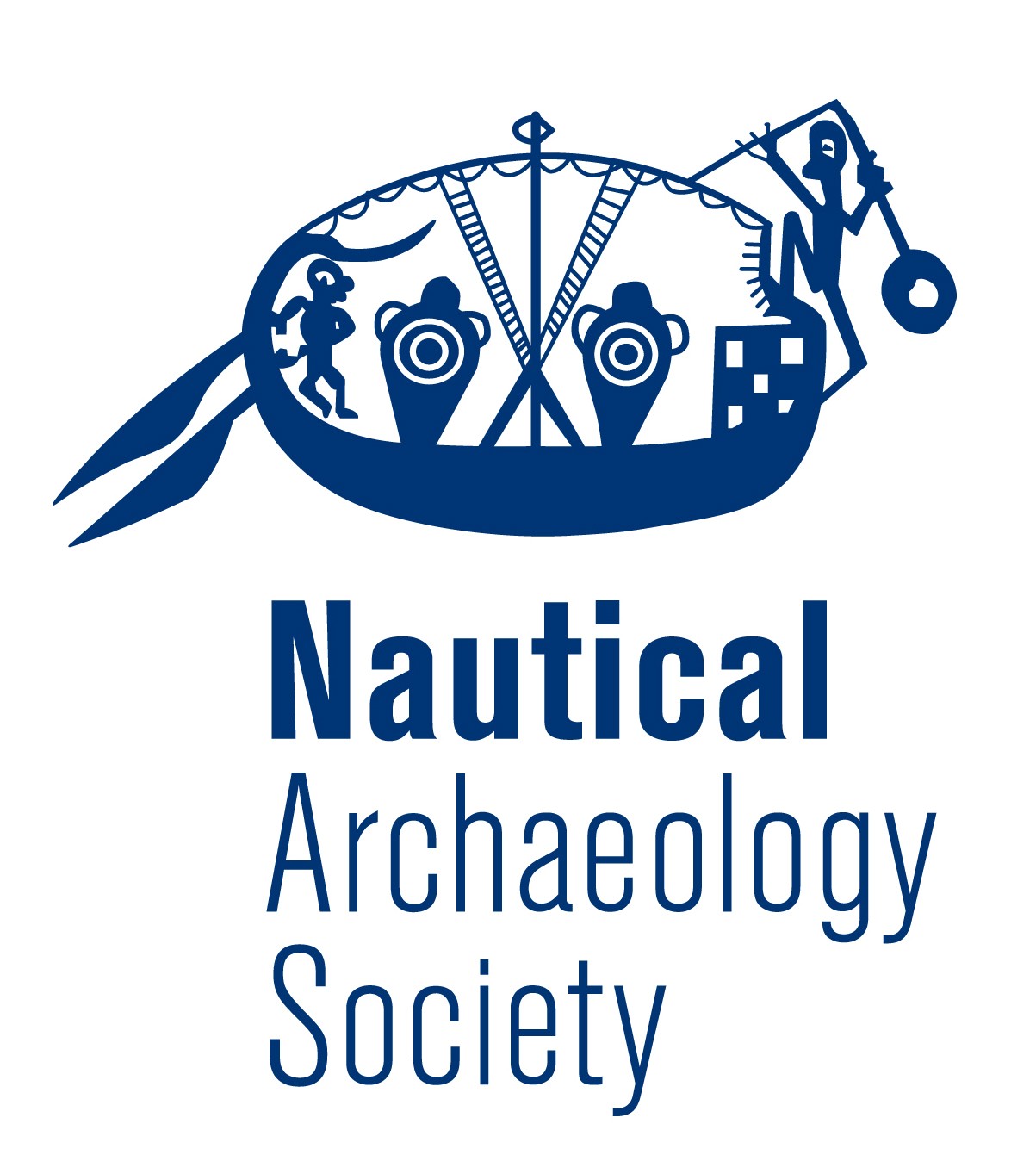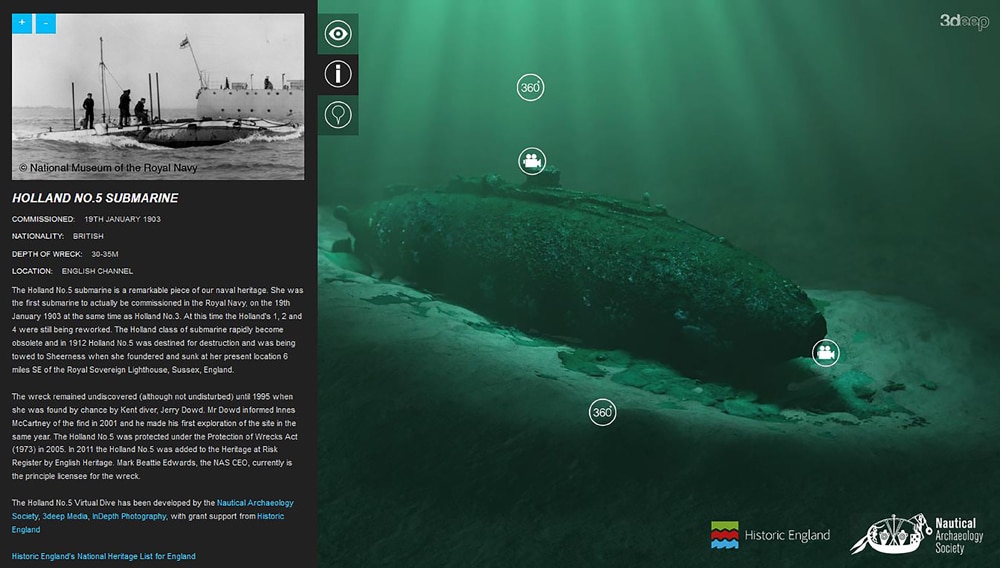News
New 3D tour of Holland 5 submarine wreck announced

 For the first time, non-divers can explore the protected historic wreck site of the Holland No.5 Submarine, which lies nine miles off the Sussex coast. She is one of the first submarines to be accepted into the Royal Navy in 1902 and carried one of the earliest periscopes. This new dive trail has been commissioned by Historic England and
For the first time, non-divers can explore the protected historic wreck site of the Holland No.5 Submarine, which lies nine miles off the Sussex coast. She is one of the first submarines to be accepted into the Royal Navy in 1902 and carried one of the earliest periscopes. This new dive trail has been commissioned by Historic England and  developed by the Nautical Archaeology Society.
developed by the Nautical Archaeology Society.
Of the 53 protected wreck sites off England, there are currently five that you can access via a protected wreck dive trail. For those who prefer to stay dry, there are now also virtual tours of some of these fascinating historic wrecks.
 The very nature of maritime archaeology, lying at the bottom of the seabed in an area only accessible by those with the right training and equipment, has meant that only a small number of people have been able to explore protected wreck sites. Over recent years, Historic England has commissioned 13 virtual dive trails on five of these sites so that everyone can tour a historic shipwreck without getting wet. The virtual trails use new technologies such as multi-image photogrammetric recording, 3D printing of geophysical survey data and virtual reality and augmented reality techniques.
The very nature of maritime archaeology, lying at the bottom of the seabed in an area only accessible by those with the right training and equipment, has meant that only a small number of people have been able to explore protected wreck sites. Over recent years, Historic England has commissioned 13 virtual dive trails on five of these sites so that everyone can tour a historic shipwreck without getting wet. The virtual trails use new technologies such as multi-image photogrammetric recording, 3D printing of geophysical survey data and virtual reality and augmented reality techniques.
These techniques allow viewers to see a clear 3D image of a site. Not only do they bring maritime archaeology to life for the non-diver, they’re a lot easier to interpret than more traditional geophysical survey techniques or photographs taken in poor visibility.
The Holland No.5 Submarine Virtual Dive
 The Holland No.5 Submarine was designated under the Protection of Wrecks Act (1973) in 1995. The site was discovered by luck by Kent based diver Gerry Jowd and his friends who just happen to drive their dive boat over the wreck and notice a lump on their echo-sounder. The wreck was protected in 2005. The site is dived every year by the Nautical Archaeology Society.
The Holland No.5 Submarine was designated under the Protection of Wrecks Act (1973) in 1995. The site was discovered by luck by Kent based diver Gerry Jowd and his friends who just happen to drive their dive boat over the wreck and notice a lump on their echo-sounder. The wreck was protected in 2005. The site is dived every year by the Nautical Archaeology Society.
The Holland No.5 submarine is a remarkable piece of our naval heritage. She was the fifth of the experimental Holland class submarines to be launched on 10 June 1902, at a cost of £35,000. She was built by Vickers, Sons and Maxim in Barrow-in-Furness, under licence from Holland Torpedo Boat Company and to a design by John Phillip Holland. She was launched one month ahead of Holland 6 (which was later designated A1). The British Holland class was an extension of the design used on USS Holland. She was equipped with one of the first periscopes; at the time of her launch, no other submarines in the Royal Navy or the United States Navy were so equipped. It was of British design, which used a ball and socket joint on the hull to raise and lower the scope. She was constructed of “s” grade steel, which at the time of her construction was only used on this class of submarine and the Forth Bridge. She utilised a single hull design, and so her pressure hull contained her fuel tanks, ballast and other internal workings. She was limited to a maximum depth of 100 feet (30m). Today the submarine is upright in 32m depth and in amazing state of preservation.
“We have been diving on the Holland No.5 Submarine since 2010 and have spent hours underwater recording the condition of the amazing wreck,” advises Mark Beattie-Edwards, NAS Chief Executive Officer and a current licensee of the wreck. “The development of the virtual dive this year means we can now share the experience of diving the wreck with the rest of the world, including the non-diving public. We hope it can raise awareness and interest in this amazing piece of underwater cultural heritage”.
Alison James, Maritime Archaeologist at Historic England said: “We are very proud of our virtual dive trails that allow people to experience protected wreck sites without getting wet. The new trail on the Holland 5 is fascinating and we hope people enjoy a virtual dive on this site.”
A series of videos have been produced and are available. You can find them all by clicking here.
To visit the virtual dive click here.
For more information on the Nautical Archaeology Society see:
www.nauticalarchaeologysociety.org
Twitter: @NautArchSoc
Facebook: https://www.facebook.com/NautArchSoc
Gear News
Introducing the TR-80, IR-50 and CS-30 Regulators from DYNAMICNORD

Whether you are a beginner or a professional diver – with the three new main regulators from DYNAMICNORD, everyone will find their favourite regulator. They all look super stylish.
Excellent performance with the TR-80
Quality and performance are the be-all and end-all for regulators. It is not for nothing that the TR stands for Tec Reg. The innovative design of the TR-80 guarantees absolute reliability – even in ice-cold waters.

Perfect breathing effort at 0.8 J/l / certified for diving in waters below 10 degrees / structural design made of solid brass for best cold protection / membrane-compensated design with dry seal of the first stage / reduced exhalation effort thanks to optimized exhalation membrane and bubble deflector / adjustable Venturi (dive/predive) and adjustment knob for individual inhalation comfort / innovative design of the front cover prevents free-flow in strong currents or when diving with scooters / design made of sandblasted brass, matt chrome finish / 2 HP and 4 LP outlets / mouthpiece made of high-quality, anti-allergic silicone for maximum comfort.


Amazing underwater adventures with the IR-50
The IR-50 is the top regulator for advanced and experienced divers. Natural breathing is the essence of this regulator.

Ideal breathing effort at 0.8 J/l /certified for diving in waters below 10 degrees / compensated membrane / adjustable venturi (dive/predive) and adjustment knob for individual inhalation comfort/ outlet valve and deflector for minimum exhalation effort and reduction of bubbles on the face / design made of sandblasted brass, matt chrome finish / 2 HP and 4 NP outlets / mouthpiece made of high-quality, anti-allergic silicone for maximum comfort.


The Workhorse – our CS-30
For diving centres and diving beginners – the workhorse stands for strong construction, reliability and robustness. Perfect for your training.

Optimal breathing effort at 0.8 J/l /recommended for diving in waters above 10 degrees / non-compensated piston / adjustable venturi (dive/predive) / outlet valve and deflector for minimum exhalation effort and reduction of bubbles on the face / design made of sandblasted brass, matt chrome finish / 1 HP and 3 NP outlets / mouthpiece made of high-quality, anti-allergic silicone for maximum comfort.


Octopus OP-30
The OP-30 is the ideal addition to all DYNAMICNORD regulators. It is identical in construction to the CS-30.

The TR-80, IR-50, CS-30 (DIN & INT) regulators and the Octopus OP-30 are available from DYNAMICNORD dealers and in the online store.
DYNAMICNORD – Your Outdoor Companion.
Marine Life & Conservation
Paul Watson Released as Denmark Blocks Japan’s Extradition Bid

Renowned anti-whaling activist Paul Watson has been released from custody in Greenland after spending five months in detention. Denmark’s Justice Ministry rejected Japan’s request for his extradition, citing insufficient guarantees that his time already served in custody would be credited against any potential sentence.
The 74-year-old Canadian-American was arrested on July 21 in Nuuk, Greenland’s capital, when his ship docked to refuel. His arrest was based on a 2012 Japanese warrant related to a 2010 encounter in Antarctic waters. Japan alleged Watson obstructed operations and caused damage to a whaling research ship during efforts to disrupt illegal whaling. Watson has consistently denied these claims, maintaining his commitment to marine conservation.
Denmark, which oversees extradition matters for Greenland, concluded that while the legal conditions for extradition were met, the lack of assurances from Japan regarding time-served credit made extradition untenable.
In a video shared by his foundation, Watson expressed gratitude and relief, saying, “After five months, it’s good to be out… and good to know they’re not sending me to Japan.” He added that the most difficult part of his time in custody was being separated from his two young sons.
Watson is a pioneering figure in marine conservation, known for founding the Captain Paul Watson Foundation in 2022 after decades of activism with the Sea Shepherd Conservation Society. His bold efforts to defend marine life have earned him widespread support, including from celebrities and conservationists. His work has also been featured in the acclaimed reality TV series Whale Wars.
Watson’s lawyer, Jonas Christoffersen, praised the decision, stating, “We are happy and relieved that Paul Watson is now free.” He added that Watson is eager to reunite with his family and continue his vital work.
The arrest occurred while Watson’s vessel, the M/Y John Paul DeJoria, was en route to the North Pacific with a team of 26 volunteers to intercept a Japanese whaling ship. His foundation described the arrest as politically motivated and emphasized that Watson’s actions were focused on ending illegal whaling practices.
Japan resumed commercial whaling in 2019 after leaving the International Whaling Commission, asserting that whale meat is a cultural tradition. Conservationists, however, continue to challenge these practices, highlighting their impact on marine ecosystems.
Despite the challenges, Watson remains steadfast in his mission to protect marine life and bring attention to whaling practices. His dedication to ocean conservation has made him a globally respected advocate for the environment.
-

 News2 months ago
News2 months agoIconic SS United States to become the World’s Largest Artificial Reef
-

 News3 months ago
News3 months agoBook Review – 52 Assignments: Underwater Photography
-

 Gear News3 months ago
Gear News3 months agoDYNAMICNORD – New German diving brand enters the British market
-

 News3 months ago
News3 months agoExploring Cenote El Pit: A Diver’s Dream
-

 Gear News3 months ago
Gear News3 months agoTry BARE drysuits (and maybe even win one!) this Friday with Sea & Sea at North West Dive Fest
-

 Marine Life & Conservation3 months ago
Marine Life & Conservation3 months agoBook Review: Coral Triangle Cameos
-

 Blogs2 months ago
Blogs2 months agoDive the Egyptian Red Sea this Autumn with Regaldive
-

 News3 months ago
News3 months ago2024 Ocean Art Underwater Photo Competition Announced













